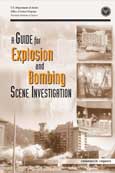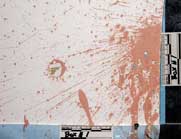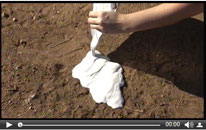|
View in browser: http://www.crime-scene-investigator.net/newsletter/1216.html
|
||
|
DECEMBER 2016 | ||
|
Welcome to the December 2016 Crime Scene Investigator Network Newsletter
| ||
|
This Month's Featured Resource on the Crime Scene Investigator Network Website
|
||

The principal purpose of this Guide is to provide an investigative outline of the tasks that should be considered at every explosion scene. They will ensure that proper procedures are used to locate, identify, collect, and preserve valuable evidence so that it can be examined to produce the most useful and effective information-best practices. This Guide was designed to apply to explosion and bombing scene investigations, from highly complex and visible cases, such as the bombing of the Alfred P. Murrah Federal Building in Oklahoma City, to those that attract less attention and fewer resources but may be just as complex for the investigator. |
||
|
Featured Video Presentation
|
||
|
Learn the basic technique for casting footwear impressions. |
||
|
New CSI and Forensic Job Announcements
|
||
|
The most comprehensive listing of Crime Scene Investigation and Forensic To be notified of job openings as they are posted, follow us on Twitter: Job Posting Alerts |
||
|
Forensic Investigator I
Sacramento Police Department, Sacramento, California, USA Final Filing Date: January 6, 2017 Perform crime scene investigations, evaluate and process evidence, examine latent fingerprints and perform related duties and responsibilities in accordance with Police Department policies and procedures. This is the entry level of the Forensic Investigator series. <View complete job listing> |
||
|
Crime Scene Specialist
Costa Mesa Police Department, Costa Mesa, California, USA Final Filing Date: Open until filled. The first application review date will be January 3, 2017 Under general supervision, performs a variety of specialized technical duties involved in processing crime scenes including collecting, protecting, and preserving evidence for criminal prosecution; and maintains records and prepares reports regarding activities. Exercises no supervision. <View complete job listing> |
||
|
Forensic Toxicologist or Trainee
Virginia Department of Forensic Science, Norfolk, Virginia, USA Final Filing Date: January 8, 2017 The candidate will independently analyze human fluids and tissues in postmortem, DUI/D and other criminal cases using chemical and instrumental methodologies, critically evaluate data, prepare Certificates of Analysis, and interpret and defend results in courts of law. In the event a fully qualified Forensic Toxicologist candidate cannot be employed, a trainee position may be offered to the most suited candidate. <View complete job listing> |
||
 |
||
|
Serologist / DNA Analyst
Hamilton County Coroner's Crime Laboratory, Cincinnati, Ohio, USA Final Filing Date: January 20, 2017 Analyzes stain material by antigenic, genetic, orother biochemical means, and compares results to tests done on samples of known origin. DNA analyses will be done incompliance with the current version of the FBI DNA Quality Assurance Standards; <View complete job listing> |
||
|
Digital Forensic Analyst
Bozeman Police Department, Bozeman, Montana, USA Final Filing Date: January 2, 2017 The Digital Forensic Analyst is responsible for supervising a secure Computer Forensic Laboratory, and working cooperatively with law enforcement with the goal of collecting, analyzing, preparing, and delivering digital evidence for criminal cases for the Bozeman Police Department. <View complete job listing> |
||
|
Latent Print Examiner
Miami Police Department, Miami, Florida, USA Final Filing Date: December 30, 2016 Develops, compares, evaluates, identifies, and prepares latent fingerprints/palm prints for court exhibits, and testifies in all courts of law as a qualified expert witness. <View complete job listing> |
||
|
Search for more job listings in Crime Scene Investigations and Forensics To be notified of job openings as they are posted, follow us on Twitter: Job Posting Alerts |
||
|
CSI in the News
|
||
|
US State Police Have Spent Millions on Israeli Phone Cracking Tech Inside the DEA: A chemist's quest to identify mystery drugs Black Female Scientist Earns Grant to Improve Rape Investigation Methods New Haven police defend arrest of reporter at crime scene FBI's DNA profiles to include more data, making them even more powerful at solving cases |
||
|
Other Resources on the Crime Scene Investigator Network Website
|
||
|
Crime Scene Investigator -- Blog
Crime Scene Investigator Forum How to Become a Crime Scene Investigator Crime Scene Response Evidence Collection Crime Scene and Evidence Photography Crime Scene Investigation Articles Video Presentations Training and Colleges Employment Bookstore Resources and Links |
||
|
Not Subscribed to this Newsletter?
|
||
|
If you are not subscribed to this newsletter, you may subscribe with this link: SUBSCRIBE via email |
||
|
To Unsubscribe
|
||
|
To unsubscribe from future e-mail newsletters, please click here: UNSUBSCRIBE Copyright ©2016 Crime Scene Resources, Inc. Crime Scene Investigator Network |

 A search of the forensic literature resulted in few references describing this type of research. Vandenberg and van Oorschot 1 reported on finding blood under paint using the Polilight™ PL500 at about 415nm. In their experiments it appears that blood was deposited directly on wood, plaster, brick, and metal and then painted over with various colors of light colored water based paint and white acrylic paint. Blood was visible under three coats of paint. From the photographs it appeared that the blood absorbed the ultraviolet light giving it a dark appearance. The authors also reported that blood could be detected under wallpaper using the Polilight™. The authors reported that a full DNA profile was obtained from blood samples under paint. Samples were subjected to Chelex™ DNA extraction and then amplified using Profiler Plus™. No attempt was made to scrape or separate the blood from the paint samples. Ray 2 also reported limited success in visualizing blood under painted surfaces 2. In her experiment the author placed both single blood drops and blood swipes on wood and then painted over the stains with up to three coats of a latex paint. An Omniprint™ 1000 and Polilight™ (150 watt model) were used to examine the stains under paint. Both units were set at 530nm. No statement was made regarding the type of filter used. The author reported that the bloodstains were “visible” to “barely visible” with the use of an alternate light source after two coats of paint were applied. The third coat of paint made the bloodstains either not visible or “questionable” in appearance with the light sources. None of the authors discussed methods for paint removal.
A search of the forensic literature resulted in few references describing this type of research. Vandenberg and van Oorschot 1 reported on finding blood under paint using the Polilight™ PL500 at about 415nm. In their experiments it appears that blood was deposited directly on wood, plaster, brick, and metal and then painted over with various colors of light colored water based paint and white acrylic paint. Blood was visible under three coats of paint. From the photographs it appeared that the blood absorbed the ultraviolet light giving it a dark appearance. The authors also reported that blood could be detected under wallpaper using the Polilight™. The authors reported that a full DNA profile was obtained from blood samples under paint. Samples were subjected to Chelex™ DNA extraction and then amplified using Profiler Plus™. No attempt was made to scrape or separate the blood from the paint samples. Ray 2 also reported limited success in visualizing blood under painted surfaces 2. In her experiment the author placed both single blood drops and blood swipes on wood and then painted over the stains with up to three coats of a latex paint. An Omniprint™ 1000 and Polilight™ (150 watt model) were used to examine the stains under paint. Both units were set at 530nm. No statement was made regarding the type of filter used. The author reported that the bloodstains were “visible” to “barely visible” with the use of an alternate light source after two coats of paint were applied. The third coat of paint made the bloodstains either not visible or “questionable” in appearance with the light sources. None of the authors discussed methods for paint removal.

